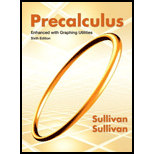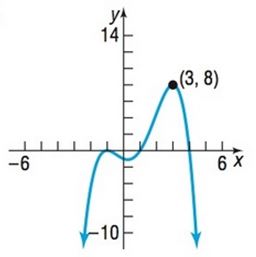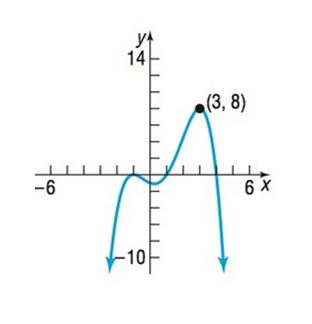Problem 1AYU: The intercepts of the equation 9 x 2 +4y=36 are ______. (pp.18-19) Problem 2AYU: Is the expression 4 x 3 3.6 x 2 2 a polynomial? If so, what is its degree? (pp. A22-A23) Problem 3AYU: To graph y= x 2 4 , you would shift the graph of y= x 2 ______ a distance of ______ units. (pp.... Problem 4AYU: Use a graphing utility to approximate (rounded to two decimal places) the local maximum value and... Problem 5AYU: True or False The x-intercepts of the graph of a function y=f( x ) are the real solutions of the... Problem 6AYU: If g( 5 )=0 , what point is on the graph of g ? What is the corresponding x-intercept of the graph... Problem 7AYU: The graph of every polynomial function is both _______ and _______. Problem 8AYU: If r is a real zero of even multiplicity of a polynomial function f , then the graph of f _______... Problem 9AYU: The graphs of power functions of the form f(x)= x n , where n is an even integer, always contain the... Problem 10AYU: If r is a solution to the equation f(x)=0 , name three additional statements that can be made about... Problem 11AYU: The points at which a graph changes direction (from increasing to decreasing or decreasing to... Problem 12AYU Problem 13AYU: If f( x )=2 x 5 + x 3 5 x 2 +7 , then lim x f( x )= _____ and lim x f( x )= _____. Problem 14AYU: Explain what the notation lim x f( x )= means. Problem 15AYU: In Problems 17-28, determine which functions are polynomial functions. For those that are, state the... Problem 16AYU: In Problems 17-28, determine which functions are polynomial functions. For those that are, state the... Problem 17AYU: In Problems 17-28, determine which functions are polynomial functions. For those that are, state the... Problem 18AYU: In Problems 17-28, determine which functions are polynomial functions. For those that are, state the... Problem 19AYU: In Problems 17-28, determine which functions are polynomial functions. For those that are, state the... Problem 20AYU: In Problems 17-28, determine which functions are polynomial functions. For those that are, state the... Problem 21AYU: In Problems 17-28, determine which functions are polynomial functions. For those that are, state the... Problem 22AYU: In Problems 17-28, determine which functions are polynomial functions. For those that are, state the... Problem 23AYU: In Problems 17-28, determine which functions are polynomial functions. For those that are, state the... Problem 24AYU: In Problems 17-28, determine which functions are polynomial functions. For those that are, state the... Problem 25AYU: In Problems 17-28, determine which functions are polynomial functions. For those that are, state the... Problem 26AYU: In Problems 17-28, determine which functions are polynomial functions. For those that are, state the... Problem 27AYU: In Problems 29-42, use transformations of the graph of y= x 4 or y= x 5 to graph each function. f( x... Problem 28AYU Problem 29AYU: In Problems 29-42, use transformations of the graph of y= x 4 or y= x 5 to graph each function. f( x... Problem 30AYU: In Problems 29-42, use transformations of the graph of y= x 4 or y= x 5 to graph each function. f( x... Problem 31AYU: In Problems 29-42, use transformations of the graph of y= x 4 or y= x 5 to graph each function. f( x... Problem 32AYU: In Problems 29-42, use transformations of the graph of y= x 4 or y= x 5 to graph each function. f( x... Problem 33AYU: In Problems 29-42, use transformations of the graph of y= x 4 or y= x 5 to graph each function. f( x... Problem 34AYU: In Problems 29-42, use transformations of the graph of y= x 4 or y= x 5 to graph each function. f( x... Problem 35AYU: In Problems 29-42, use transformations of the graph of y= x 4 or y= x 5 to graph each function. f( x... Problem 36AYU: In Problems 29-42, use transformations of the graph of y= x 4 or y= x 5 to graph each function. f( x... Problem 37AYU: In Problems 29-42, use transformations of the graph of y= x 4 or y= x 5 to graph each function. f( x... Problem 38AYU: In Problems 29-42, use transformations of the graph of y= x 4 or y= x 5 to graph each function. f( x... Problem 39AYU: In Problems 29-42, use transformations of the graph of y= x 4 or y= x 5 to graph each function. f( x... Problem 40AYU: In Problems 29-42, use transformations of the graph of y= x 4 or y= x 5 to graph each function. f( x... Problem 41AYU: In Problems 43-50, form a polynomial function whose real zeros and degree are given. Answers will... Problem 42AYU: In Problems 43-50, form a polynomial function whose real zeros and degree are given. Answers will... Problem 43AYU: In Problems 43-50, form a polynomial function whose real zeros and degree are given. Answers will... Problem 44AYU: In Problems 43-50, form a polynomial function whose real zeros and degree are given. Answers will... Problem 45AYU: In Problems 43-50, form a polynomial function whose real zeros and degree are given. Answers will... Problem 46AYU: In Problems 43-50, form a polynomial function whose real zeros and degree are given. Answers will... Problem 47AYU: In Problems 43-50, form a polynomial function whose real zeros and degree are given. Answers will... Problem 48AYU: In Problems 43-50, form a polynomial function whose real zeros and degree are given. Answers will... Problem 49AYU: In Problems 57-68, for each polynomial function: (a) List each real zero and its multiplicity. (b)... Problem 50AYU: In Problems 57-68, for each polynomial function: (a) List each real zero and its multiplicity. (b)... Problem 51AYU: In Problems 57-68, for each polynomial function: (a) List each real zero and its multiplicity. (b)... Problem 52AYU: In Problems 57-68, for each polynomial function: (a) List each real zero and its multiplicity. (b)... Problem 53AYU: In Problems 57-68, for each polynomial function: (a) List each real zero and its multiplicity. (b)... Problem 54AYU: In Problems 57-68, for each polynomial function: (a) List each real zero and its multiplicity. (b)... Problem 55AYU: In Problems 57-68, for each polynomial function: (a) List each real zero and its multiplicity. (b)... Problem 56AYU: In Problems 57-68, for each polynomial function: (a) List each real zero and its multiplicity. (b)... Problem 57AYU: In Problems 57-68, for each polynomial function: (a) List each real zero and its multiplicity. (b)... Problem 58AYU: In Problems 57-68, for each polynomial function: (a) List each real zero and its multiplicity. (b)... Problem 59AYU: In Problems 57-68, for each polynomial function: (a) List each real zero and its multiplicity. (b)... Problem 60AYU: In Problems 57-68, for each polynomial function: (a) List each real zero and its multiplicity. (b)... Problem 61AYU Problem 62AYU Problem 63AYU Problem 64AYU Problem 65AYU Problem 66AYU: In Problems 73-76, construct a polynomial function that might have the given graph. (More than one... Problem 67AYU Problem 68AYU Problem 69AYU: In Problems 77-80, write a polynomial function whose graph is shown (use the smallest degree... Problem 70AYU: In Problems 77-80, write a polynomial function whose graph is shown (use the smallest degree... Problem 71AYU: In Problems 77-80, write a polynomial function whose graph is shown (use the smallest degree... Problem 72AYU: In Problems 77-80, write a polynomial function whose graph is shown (use the smallest degree... Problem 73AYU Problem 74AYU: In Problems 81-98, analyze each polynomial function by following Steps 1 through 8 on page 193. f( x... Problem 75AYU Problem 76AYU Problem 77AYU: In Problems 81-98, analyze each polynomial function by following Steps 1 through 8 on page 193. f( x... Problem 78AYU: In Problems 81-98, analyze each polynomial function by following Steps 1 through 8 on page 193. f( x... Problem 79AYU Problem 80AYU Problem 81AYU Problem 82AYU Problem 83AYU Problem 84AYU Problem 85AYU: In Problems 81-98, analyze each polynomial function by following Steps 1 through 8 on page 193. f( x... Problem 86AYU Problem 87AYU Problem 88AYU Problem 89AYU Problem 90AYU: In Problems 81-98, analyze each polynomial function by following Steps 1 through 8 on page 193. f( x... Problem 91AYU Problem 92AYU: In Problems 99-106, analyze each polynomial function f by following Steps 1 through 8 on page 195.... Problem 93AYU: In Problems 99-106, analyze each polynomial function f by following Steps 1 through 8 on page 195.... Problem 94AYU Problem 95AYU Problem 96AYU Problem 97AYU Problem 98AYU Problem 99AYU Problem 100AYU: In Problems 107-114, analyze each polynomial function by following Steps 1 through 8 on page 193. f(... Problem 101AYU Problem 102AYU: In Problems 107-114, analyze each polynomial function by following Steps 1 through 8 on page 193. f(... Problem 103AYU: In Problems 107-114, analyze each polynomial function by following Steps 1 through 8 on page 193. f(... Problem 104AYU Problem 105AYU Problem 106AYU: In Problems 107-114, analyze each polynomial function by following Steps 1 through 8 on page 193. f(... Problem 107AYU Problem 108AYU Problem 109AYU Problem 110AYU: In Problems 115-118, construct a polynomial function f with the given characteristics. Zeros:4(... Problem 111AYU: G( x )= (x+3) 2 (x2) a. Identify the x-intercepts of the graph of G . b. What are the x-intercepts... Problem 112AYU: h( x )=( x+2 ) ( x4 ) 3 a. Identify the x-intercepts of the graph of h . b. What are the... Problem 113AYU Problem 114AYU Problem 115AYU Problem 116AYU: h( x )=( x+2 ) ( x4 ) 3 a. Identify the x-intercepts of the graph of h . b. What are the... Problem 117AYU Problem 118AYU Problem 119AYU: Write a few paragraphs that provide a general strategy for graphing a polynomial function. Be sure... Problem 120AYU Problem 121AYU: Make up two polynomials, not of the same degree, with the following characteristics: crosses the... Problem 122AYU: Which of the following statements are true regarding the graph of the cubic polynomial f( x )= x 3... Problem 123AYU: Which of the following statements are true regarding the graph of the cubic polynomial f( x )= x 3... Problem 124AYU: The illustration shows the graph of a polynomial function. a. Is the degree of the polynomial even... Problem 125AYU Problem 126AYU format_list_bulleted



 Calculus: Early TranscendentalsCalculusISBN:9781285741550Author:James StewartPublisher:Cengage Learning
Calculus: Early TranscendentalsCalculusISBN:9781285741550Author:James StewartPublisher:Cengage Learning Thomas' Calculus (14th Edition)CalculusISBN:9780134438986Author:Joel R. Hass, Christopher E. Heil, Maurice D. WeirPublisher:PEARSON
Thomas' Calculus (14th Edition)CalculusISBN:9780134438986Author:Joel R. Hass, Christopher E. Heil, Maurice D. WeirPublisher:PEARSON Calculus: Early Transcendentals (3rd Edition)CalculusISBN:9780134763644Author:William L. Briggs, Lyle Cochran, Bernard Gillett, Eric SchulzPublisher:PEARSON
Calculus: Early Transcendentals (3rd Edition)CalculusISBN:9780134763644Author:William L. Briggs, Lyle Cochran, Bernard Gillett, Eric SchulzPublisher:PEARSON Calculus: Early TranscendentalsCalculusISBN:9781319050740Author:Jon Rogawski, Colin Adams, Robert FranzosaPublisher:W. H. Freeman
Calculus: Early TranscendentalsCalculusISBN:9781319050740Author:Jon Rogawski, Colin Adams, Robert FranzosaPublisher:W. H. Freeman
 Calculus: Early Transcendental FunctionsCalculusISBN:9781337552516Author:Ron Larson, Bruce H. EdwardsPublisher:Cengage Learning
Calculus: Early Transcendental FunctionsCalculusISBN:9781337552516Author:Ron Larson, Bruce H. EdwardsPublisher:Cengage Learning




